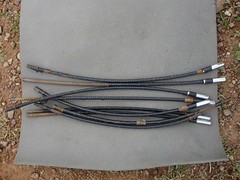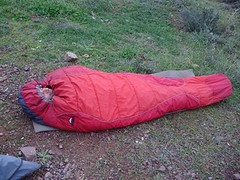Gear: What You Need to Walk Around the Earth
source -
WorldWalk-Peacetour blogWalking and backpacking around the Earth is an extremely strong load test on your gear. But you have a real chance to prove its quality or its flaws: The brothers walked and put up their tents in France in frost, in the Sahara in 100 °F, they were hit by a hard thunderstorm in Austria, and a much harder sand storm in Africa, they spent many days among high mountains in the Alps, wandered on huge plains in France and in wild forests in Germany. I can say that they checked their gear in every imaginable situation. After the European and the African stage of the trip we’ll try to summarize their experiences and opinions about their tents, sleeping bags, backpacks, mats, trousers and shoes. Also, a new continent’s ahead, new soils, new climate. Probably they have to replace some of their equipment before moving on.
Tents: An Indispensable Base
Your tent is your home during backpacking. And if you backpack for 6 years, you try to choose the perfect one. Sometimes you succeed, sometimes you don’t.
The boys bought their tents an InterSport shop for about 120 euros (US$150). These are McKinley Compact Light 2 tents, a run-out model, but there’s a similar one on the official McKinley page: the Enduro Light. The manufacturer’s description:
Ultra-lightweight tunnel tent for 2 people, ideal for travelling and on trekking and cycle tours. Outer skin made of PU-coated polyester, all seams sealed with seam tape, 3,000 mm water column. 1 entrance, 2 frame arches made of aluminium. Tent pegs made of aluminium.2 frame arches made of aluminium: It became obvious soon enough that these arches hadn’t been designed for everyday use. When you put up the tent you have to bend these pipes to the arch shape, and when you dismantle your tent in the morning these are straightened again. It was too much for them, in a month they were beginning to break one by one. Of course they were very-very light, but useless.

That time Ferenc and István were working in Spain on a construction of a house in the mountains. The foundations of that house was made of reinforced concrete. They got some rebars, and made their own frame arches. These arches were pre-bent by them and covered by many plastic tapes to keep the skin and the floor of the tent safe. The advantages of these arches were obvious: they’re very stable, no winds or storms beat them. The disadvantages are obvious, too: they’re damn heavy. So our advice to the manufacturer: please, pre-bend the arches, and don’t force the backpackers to bend them.
Tent pegs made of aluminium: This seems to be a joke, here you have the photos of them. Aluminium is too soft, the tip of the pegs became dull soon, they bend easily and can harm your hands.
 Zippers
Zippers: These are far too weak, ideal for a schoolbag, but not for a tent that is to be used in Africa. Somewhere in Mauritania they even had to saw a velcro to keep out the mosquitos (they seemed to be infected by malaraia).
Skin: The strong-point of these tents, there was no trouble with it whatsoever. Now there are some holes, protection from rain isn’t perfect, but the life of these tents haven’t been easy at all. So that’s just fine.
Sleeping Bag: Like Napoleon Bonaparte“The bed has become a place of luxury to me! I would not exchange it for all the thrones in the world”, Napoleon Bonaparte said once.

The Denali Alpine 19 sleeping bags of the WorldWalkers were purchased in the same InterSport shop, unfortunately they can’t recall its price. The manufarturer’s comments:
Sleeping bag suitable for Alpine conditions, ideal companion while mountain climbing and on trekking and Alpine tours. The comfort range lies between +3°C and -3°C, the extreme range lies at -19°C. The double layer concept offers maximum loft and heat retention qualities. Ergonomic hood with corded seam at forehead, padded heat collar, shoulder extension and thermally enhanced foot part ensure optimum heat retention qualities. Excellent sleeping comfort through the use of robust, lightweight and breathable materials.Ferenc and István have been very satisfied with the product, so far. As the manufacturer promised it provides comfort down to 25 °F. It needs a small space when packed, and it’s light enough. There was only one disadvantage revealed: the zippers, again. These are a bit stronger then the tents’, but they’ve been giving up. And the winter in Málaga is cold enough.
Backpack: A Snail’s Life
Snails carry their shell (i.e. their “house”) on their backs, in a similar way the brothers carry all their personal stuff on their backs. And to make their life as comfotable as possible, they needed a fine backpack. They have been using Quecha Forclaz backpacks for a while, and they are fully satisfied with them. Zippers are placed in the middle of the backpack, so you can easily reach the inner parts. If you need your foorth bottle of water in the desert, it’s really handy that you don’t have to get out the three empty bottles to find the full one. The raincoat was a bit surprising for then. The backpack itself is not water-resistant, if you want to make it water-resistant, you have to cover it. Close to the fasteners the textile has begun to break, and a couple of the many zippers broke down already, but these backpacks have survived the Sahara, so there’s nothing to complain about.













 Previous Topic
Previous Topic Index
Index







